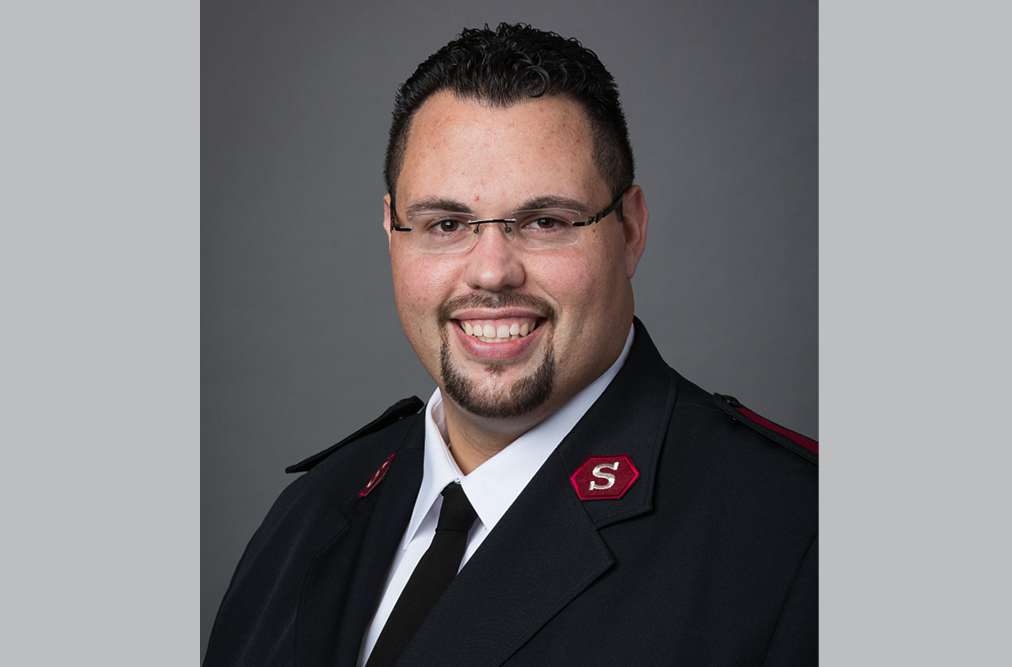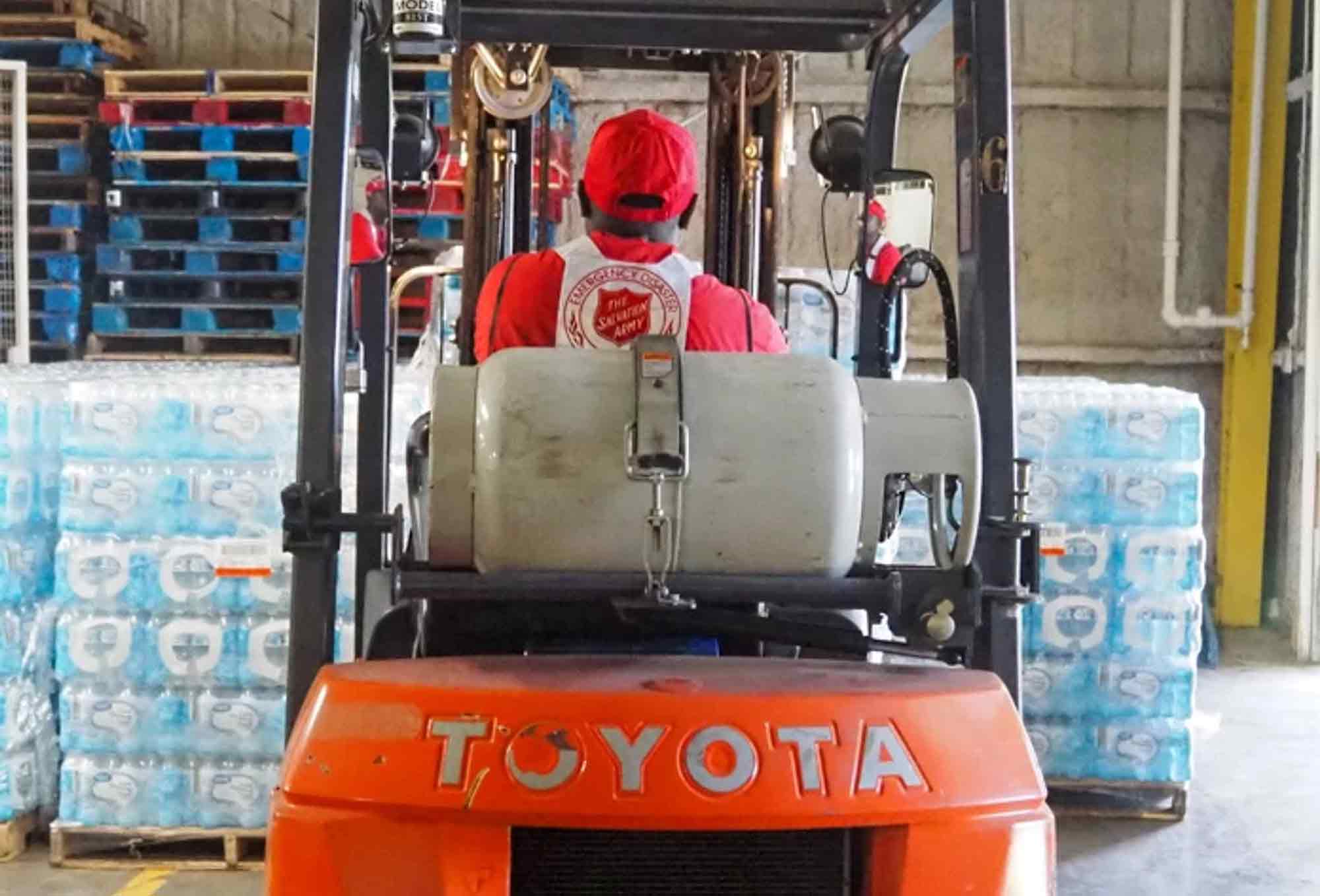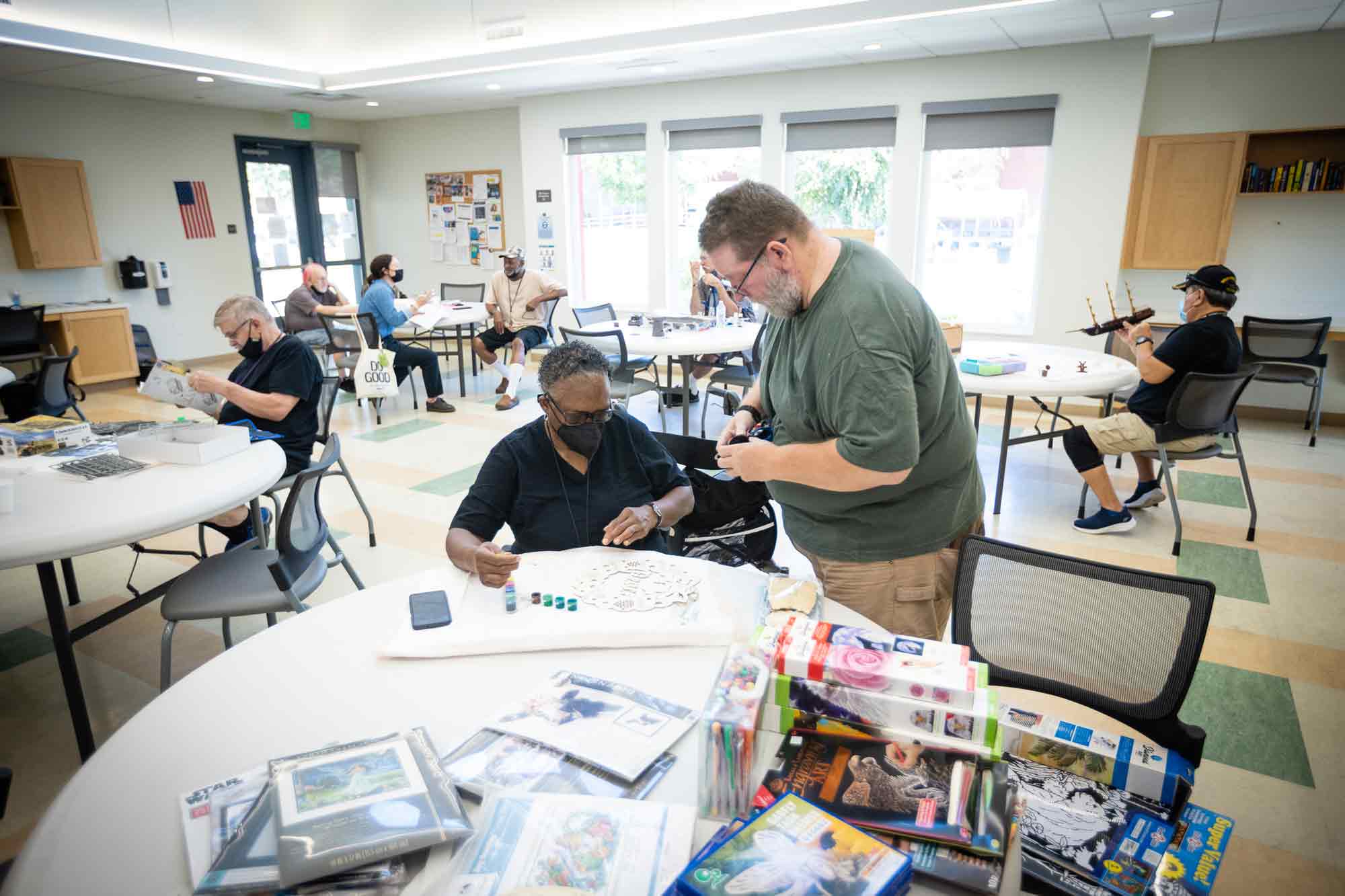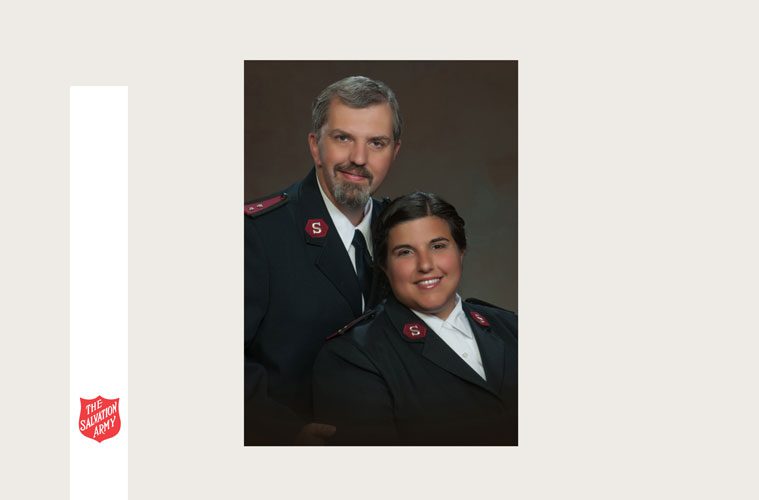It won’t come as a surprise to you that the number of employed people plummeted as the pandemic unfolded.
In April 2020, the unemployment rate reached 14.8%—the highest rate observed since data collection began in 1948.
Compare that to February this year, 2022, when the unemployment rate marked 3.8 percent.
Now, we hear a different story about America’s worker shortage. In January, the U.S. had 11.3 million jobs to fill and not enough workers to do so, according to the Bureau of Labor Statistics. You’ve probably seen the “help wanted” signs in your own community.
And so The Salvation Army retooled its own programs for workforce development in Northern California in an effort to more quickly prepare workers for skilled jobs.
And notably, help people out of or altogether prevent homelessness.
Captain Larry Carmichael is the Social Services Officer for The Salvation Army in Sacramento County.
He was commissioned as a Salvation Army officer, or pastor, in 2016 and has since served in Phoenix; in Marin County, California, and now in Sacramento. He holds a master’s degree in organizational leadership and has a personal commitment to persevere.
He’s on the show to share more about The Salvation Army’s workforce development programs ranging the construction, culinary and certified nursing assistant fields.
It’s an effort, he says, to help an individual and a community.
Show highlights include:
- More about Captain Larry Carmichael’s story.
- Why he has a personal commitment to persevere, to meet the challenge rather than wishing it away.
- What led him to become a pastor, an officer in The Salvation Army.
- What he does now as the Social Services Officer for Sacramento County.
- The need he is seeing most in the community.
- More about recent efforts of The Salvation Army Del Oro Division—spanning Northern California and Northern Nevada—in workforce development, including culinary (Sacramento, Lodi, Napa Valley), construction (Sacramento, Alameda) and Certified Nursing Assistant (Alameda) programs.
- How these programs changed in light of the pandemic and resulting changes in the job market.
- How The Salvation Army finds students.
- How participants connect to jobs after program completion.
- One student’s full circle story.
- How workforce development helps not only an individual but also the community.
- How to get involved or support the effort.
Listen and subscribe to the Do Gooders Podcast now. Below is a transcript of the episode, edited for readability. For more information on the people and ideas in the episode, see the links at the bottom of this post.
* * *
Christin Thieme: Captain Larry, welcome to the Do Gooders Podcast. Thank you so much for joining us today.
Larry Carmichael: Thank you for allowing me to come and share a bit about what’s happening throughout the Del Oro Division.
Christin Thieme: Yeah, I can’t wait to hear all about it. As we start out here though, can you tell us a little bit more about who you are? What’s your story? I realize that’s a very big question, but maybe a few highlights of what brought you to where you are and now today.
Larry Carmichael: Yeah. So my story, a quick highlight glimpse of it is that I was born to parents of addiction and vices and that led to me being raised by my paternal grandparents. So from the age of 10 months to adulthood, I grew up in the home of loving and care of my father’s parents. And that allowed for me to grow up as an old soul a child being raised by 50 and 60 year olds tends to turn out a little bit different.
You become a homebody, you become more meditative and quietness is expected type of thing. And part of that is also getting to learn from their additional years of wisdom. And so, as I grew up, I was alongside them as they were in the heights of their careers or in their height of public service. And just seeing that we exist, not just for the family, not just for the household, not just for ourselves, but to serve others and to be engaged in a community.
Christin Thieme: Yeah. I’ve heard you say that you have a personal commitment to persevere, to meet the challenge rather than wishing it away. And you’ve said that’s because of how you were raised. Can you share a little bit more about that?
Larry Carmichael: Yeah. I have a distinct memory of being 8 or 9 years old and each morning I would join my grandmother for a morning walk and we’d walk for a couple miles. And she would take the time to just share life with me a bit. And she would use different stories that had come up the day before in her life or whatever to teach me a lesson. And one particular day she was sharing with me how there was a lady that just was wanting to just do whatever was comfortable to her or whatever made her feel good or what have you.
And that life can’t be done that way, that life requires you to do what you need to do even if they’re hard. Keep on pushing through it because that creates the results that makes life fully enjoyable, full of that joy, full of significance for a lifetime and improves your life and the life of others. And I just remember that walk and that particular conversation and just thinking to myself, “Okay, it’s not just the easy stuff you have to pursue the hard stuff, even though it’s hard.”
Christin Thieme: Yeah. Some insightful wisdom for a morning walk. I love that you took morning walks with your grandma. That’s so sweet.
Larry Carmichael: Yeah. But I love her. She’s good people.
Christin Thieme: Of course. So what led you then to become a pastor, an officer in The Salvation Army?
Larry Carmichael: So in my childhood home, there was a belief of God, but a pretty firm stance against organized religion. In my grandfather’s childhood and young adult years, he had been burned by the church. My grandmother had a very similar experience and so they didn’t want organized church and religion. And so what did I do as a teenager to rebel? I went to church.
Christin Thieme: There’s worse things.
Larry Carmichael: Exactly. The end result though is that involved being a teenager, I’d be grounded from church. So that’s its own unique situation as well. And going to church very early on, I sensed a calling to pastoral work. I was 12 years old the first time that I sensed that I was meant to be a pastor. I had the joy in my 20s of serving two different congregations and then finding my way to The Salvation Army, where I had just finished college. I was looking for a summer gig before grad school and was hired on to the residential camp program in Arizona at Camp Ponderosa Ranch. And in the first week I get there and find out Salvation Army is a church. Okay, that’s weird. I had no idea about that.
Now I understand the word salvation in their title. Okay. And becoming intrigued during orientation that there would be a church known for its hands and feet of service and compassion rather than its exact location or its doctrine. And that captivated me because in my previous pastoral role, my greatest frustration was getting the church to pay attention to people beyond their walls, to the community around them. And here was a church that was intentionally looking to the community around them and it captivated me. We moved forward into week three, we received a camper who within two hours of arriving had physically assaulted three other campers, a counselor, and added a hole to our office wall.
Christin Thieme: Oh wow. It’s quite the entry.
Larry Carmichael: Indeed, indeed. And then grabbing his camper packet calling his parental contact as we called the parental contact, their response was, “I don’t care if you call Child Protective Services. He’s not coming back here.” And in additional conversation, we found out that had been his fifth foster home that year and we were the transition plan to foster home number six. We were only in June, so he was averaging one foster family a month. And so we hung up the phone and as a program team just said, “We don’t know how this is going to work, but this kid needs to know that there’s people here on earth that aren’t going to reject him. And more importantly, that there’s a God in heaven that loves him and we’ll never leave him.”
And so we paired that child with our most patient, gentle, kind counselor, put him into a cabin group with an extra counselor just to try and make the best of the situation and hopefully bring some transformation to his life. The next day, the counselor came up to us and said, “Hey, he’s walking out of his shoes. Can we get him a new pair?” So we found out his shoe size and ran into the little town of Heber. And I don’t know if folks are familiar with Heber, but Family Dollar is the place to do your shopping there, a little town of 2,500 people, and picked up a pair of knockoff white Chucks. Pretty boring for a 9 or 10-year-old boy, but that’s what was there and that was in his size, picked up socks, underwear, et cetera.
And at lunchtime pulled him to the side so that he wouldn’t be embarrassed and what have you, and presented the shoes. And I thought that he was not going to be pleased because they were such boring plain white shoes. But as he just stared at him eventually he was asked, “Lee, is there something wrong?” And he goes, “I’ve never had shoes with a tag on it before.” And there was just something in that moment where I knew within my heart of hearts that whether I was the one handing the shoes or doing all the administrative work behind it, that I wanted that to happen again and again. And I wanted that the rest of my life to be in that type of service. Giving first opportunities, first practical ways of love to those that had not seen or received love in such simple and yet impactful ways.
Christin Thieme: Yeah, what an experience.
Larry Carmichael: Yeah. So I finished that summer, moved to Portland, started grad school, became a member of The Salvation Army church. I went off to officer training in 2014 and have had the joy and opportunity to serve as a pastor in The Salvation Army since 2016.
Christin Thieme: And now in Sacramento County as the social services officer. So kind of what you wish for even that administrative work. Can you explain a little bit more about what you do in this role?
Larry Carmichael: Yeah. So in my current role, it’s one of those gigs that it’s a great one if you can get it. I get to really lead a wonderful team of 55-plus individuals overseeing a variety of programs. Everything from a 140-bed emergency shelter in Sacramento’s downtown to an apartment complex that has 34 units where we welcome families straight off the street into transitional living, and they can be with us up to two years and learn self-sufficiency and rebuild and redeem their lives a step at a time.
Transitional living center also back in the downtown region, 70 beds sober living for those that have completed their first stages of recovery, but need ongoing support and stabilization to have long-term sobriety. We also have a family services center in the north part of the county that serves approximately 131,000 people each year with food, rental, utility assistance. I have the joy of overseeing the county Christmas program that serves up to 4,000 families working very directly in leading of the advisory board in the Sacramento region fundraising for all the programs within Sacramento.
Our annual budget is a little over 10 million. And so making sure that every program that needs money is fully funded to accomplish their work, whether it’s youth programs in the south part of Sacramento, community and senior programs further south in the county or the social services work. And apart from, that coordinating the spiritual care and discipleship of all those in our social programs and connecting them to the course through monthly ministry coordination and event planning and fundraising meetings with the seven of us officers currently assigned within the Sacramento County coordination.
Plus what we’re here to talk about today, two different workforce development programs, one in culinary arts and one in construction.
Christin Thieme: Well, I think it’s safe to say that you are not short on things to do then.
Larry Carmichael: No, I love it.
Christin Thieme: That’s awesome. Can you give us a little bit of the picture of the area you’re in? I mean, what’s the theme that you’re most seeing right now in your community?
Larry Carmichael: Yes. So much like anyone currently living in California or any of the western states, really even within Colorado, homelessness. We have a crisis of an issue with it. In Sacramento County, we’ve seen since 2019 at least a 155% increase in homelessness. We’ve gone from 5,000 unsheltered in our community to over 11,000 unsheltered in our community while very quickly and rapidly opening up new housing opportunities. And so alongside of homelessness comes needs for addiction treatment services. Comes the need for additional housing services. The need for additional housing period.
The need for job skill training. The reality being that many employers need a reasonable level of skilled labor. And that walking in from the street may not get you the job that you need in order to survive here. And so in tackling homelessness comes a need to tackle labor shortages and resource shortages in our community.
Christin Thieme: And so that’s, like you said, what we’re here to talk about today, more about this workforce development effort of the Del Oro Division, which for those who aren’t familiar spans Northern California and Northern Nevada. Can you give us a little bit of an overview of what are these efforts?
Larry Carmichael: Yeah. So starting more closely in the Bay Area. We have Alameda County, which it’s known having the city of Oakland, but there in Alameda County we have a nursing program, a certified nursing assistance program, as well as a construction training program. Moving a little bit further up. We have in Lodi, a culinary arts training program that has been in existence actually since 2008, training session after session there. Hopping over to Napa, we have a culinary arts training program there. And then coming even just further north and east, we have Sacramento where we have culinary and construction.
Christin Thieme: I love it. How many students do you see in a normal year?
Larry Carmichael: In a given year, each program is able to receive in between 35 and 75 students depending on course structure and how many offerings we’re able to achieve based off of funding resources.
Christin Thieme: Have the programs changed in light of all things pandemic? I mean, I’m sure there were shifts that had to be made, but post-pandemic, how are things looking at this point?
Larry Carmichael: Oh yes, the pandemic definitely had its impact on the programs. Pre-pandemic, there was a good amount of waiting lists to get into these programs that cost nearly nothing or nothing to the student, to the program participant. In the heart of the pandemic, that dried up. Post-pandemic, we’re having to figure out a whole new recruiting model. In the Sacramento region we have what was a 16-week culinary arts training program that we’ve now retooled and restructured to be eight weeks long discovering that we literally have restaurants poaching the students out of our class once they get very specific certifications.
And so the student doesn’t even complete the training before they’re out the door. And so we’ve retooled it to where now they’re with us eight weeks and then they extern for another eight weeks in a restaurant environment to where we’re still getting to journey with them for 16 weeks, make sure they have the skills and the tools that they need to succeed, but also make sure that the community has the worker that it needs.
Christin Thieme: How do you go about finding participants? What does that recruiting strategy look like?
Larry Carmichael: Well, pre-pandemic most of our recruiting came to us from internal programs of The Salvation Army. Many of our students were graduates of the Adult Rehabilitation Centers, coming straight from the close by Adult Rehabilitation Center, whether it was Oakland or Stockton or San Francisco, Sacramento when it had one. And straight into our programs, gaining the tools that they need, being in a safe, sober environment to continue on and then off to work they went.
Now, post-pandemic, our participants are coming much more from the direct community. Whether it’s through flyers, distributed, given out to community partners, community training agencies, working with school districts with their adult learners programs, chamber of commerces, other shelters or transitional living programs. And also in the Oakland area. A wonderful story that was shared with me just this morning is that they have a street level team that goes out and does intentional case management work in the encampments in the homeless encampments around Oakland.
Well, their mobile case manager took it upon themselves to take flyers along. And so they’re getting students straight out of the encampments into the programs. And then while at it having enough trust developed to bring them indoors and move them forward into not just the employment that they’ll need to be able to be self-sufficient, but also into housing.
Christin Thieme: That’s pretty incredible.
Larry Carmichael: The efforts that we’re doing combined to transform a life, those are cool moments. And I’m thanking God for that mobile outreach case manager that just said, “Hey, how about I hand these out?” And took it upon themselves to further our mission and literally to the street.
Christin Thieme: Yeah, definitely. So it sounds like you don’t have to do much for these students to find jobs in the current job market, but in general, how do you help these students connect to jobs once they complete the program?
Larry Carmichael: Yeah. It’s not irregular for me to get phone calls from general contractors from various restaurant owners or facilities just asking, “When is your next session graduating? When is your next session done?” There’s been a few times where I’ve had a general contractor just say, “I’ll take all 10 students.” Well, how about you take the time to interview them and perhaps some of them will work for you? Not all them may want to work directly for you. They might want to go into a different trade.
Both of our different construction training programs, they give a broad spectrum to the 26 major trades. Some of our students choose to go into plumbing, others choose to go into electrical. Some choose to go into asphalt and concrete. So we invite them in now. They come in, they interview the students and I’ve yet to have a student not hired by time the courses were done. It’s a neat partnership. It’s a neat pairing. And I’m just grateful that we have a community that’s wanting this resource.
Christin Thieme: Yeah, absolutely. And it sounds like it’s a really is successful one. Over the years that you’ve been involved in this is there any particular student that stands out to you or can you share a story of kind of the individual level impact of these programs?
Larry Carmichael: Yeah. I have quite a few stories, but the one that I think I want to share is a lady by the name of Maria. She came to us after having had a career as an elementary school educator. And like so many that we find in a situation of homelessness, she had fallen on hard times, had some family trauma that resulted in the loss of her housing, which eventually caused her to become homeless, which then led to mental health issues. And by the time she came through our doors, she was needing to be helped and be restablized.
And thankfully because of the Women’s Auxiliary program group here in Sacramento that supports The Salvation Army’s work and mission, her bed was scholarshiped by their generous grant and care. And we were able to connect her like any of our students, they all receive wraparound case management and services. We connected her to behavioral health so she regained mental clarity. Then she entered our culinary arts training program where she completed the 16-week program, graduated, went to work in one of the top restaurants in the city and rebuilt her life from the ground up earning her own paycheck, getting her own apartment and getting to thrive again, reconnecting with her children.
And just recently we got the update from her that she was able to reapply for her teaching credentials. And although she loved her time in workforce development and her time in culinary, that this fall she’ll be returning back to the classroom as an elementary educator again. And so, yes, we trained her for culinary. Yes, our community benefited from her cooking some great meals, but now our communities get the benefit of her life being redeemed to teach children.
And with all of our students, we track them for at least two years after program completion to make sure that they’re staying sober, that they’re staying in a good place, maintaining their goals, working towards their goals. And we also work with their employers to make sure if there’s any additional training that we’re right there to assist in that.
Christin Thieme: Wow. That is incredible. It’s a full circle story right there.
Larry Carmichael: Yeah.
Christin Thieme: So there’s no doubt that workforce development helps the individual, but it also helps the community. And you started this out by saying that this really is an effort to impact homelessness in the area. Can you talk a little bit more about what is the impact of this kind of program—in so many communities in the area—for the broader community?
Larry Carmichael: Yeah. As it’s easy to kind of conclude or put together, part of the reason that we have a housing shortage in California is that it’s so expensive to build here. And why is it in part so expensive to build here? Because there’s not enough laborers. There’s not enough hands and feet in the trades to literally build the community, literally build the infrastructure that makes our cities and towns what they are. And so by creating the construction training programs, we’re creating the laborers needed to build affordable housing.
By doing the culinary programs, we’re creating the skilled workers that our restaurants need to care for the service industry. And to ensure that California is a great place for people to visit. Our state has a large amount of tourism. Well, we want to keep that tourism. We want to keep that, those dollars coming into our communities creating economic impact and opportunity.
With the nursing program, our society is aging and more and more CNAs and RNs are going to be needed. Well, why not create an opportunity in partnership with others to where those currently perhaps considered the least of these are moved into a whole new way introjection and become the caretakers for our current aging population, and for those that are coming up behind them. It’s the skilled workers, it’s the compassionate workers that we need to bring hope and maintain hope in the community that we all get to be a part of.
Christin Thieme: I love it. Well, how can someone who’s listening get involved and support these efforts for The Salvation Army?
Larry Carmichael: Well, if you know someone that is needing an opportunity to change their life and has interest in workforce development, whether it’s to become a certified nurse assistant, whether it’s to enter the construction trades or culinary arts, send them toward us. We are always looking for the next great student, the next great opportunity to serve.
If you find it in your financial capacity or ability to give, then head on over to our landing page, gosalarmy.org, click on workforce development, learn more about us and donate in the community that you want to see impacted further with us. Or if you happen to be an employer in the communities mentioned during this episode and would be willing to help us train soft skills, do interviews, mock interviews, et cetera, with our students, we also need that help. We need that support as well as our culinary arts training programs. They complete their program by serving a very delicious meal that they get graded on. So we even need people to come and be taste testers.
Christin Thieme: Somebody has to do it.
Larry Carmichael: Someone has to have that three-course meal with a delicious dessert. It might as well be someone that has a love and care for the Army and wants to do good.
Christin Thieme: There you go. Lots of ways to get involved then. Well, Captain, thank you so very much for sharing and for the work that you’re doing. It’s really cool to hear about.
Larry Carmichael: Yeah. Thank you, Christin. And thank you for making sure that our story gets shared and that the world around us knows that good is happening in their communities. They can join it too.
Additional resources:
- Read how the culinary training program in Lodi, California, helped one woman set a new path.
- Listen to the Do Gooders Podcast Episode 11 How Salvation Army culinary students train for the workforce with Chef Paul Fields.
- Get on the list for Good Words from the Good Word and get a boost of inspiration in 1 minute a day with a daily affirmation from Scripture sent straight to your inbox. It’s an email to help you start your day with goodness.
- It’s because of people like you that The Salvation Army can serve more than 31 million Americans in need each year. (That’s almost one person every second, every day.) Your gift helps The Salvation Army fight for good all year in your community. It’s an effort to build well-being for all of us, so together we rise. And that good starts with you. Give to spread hope with a donation of funds, goods or time today.
Listen and subscribe to the Do Gooders Podcast now.

















